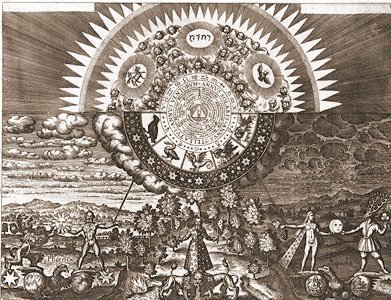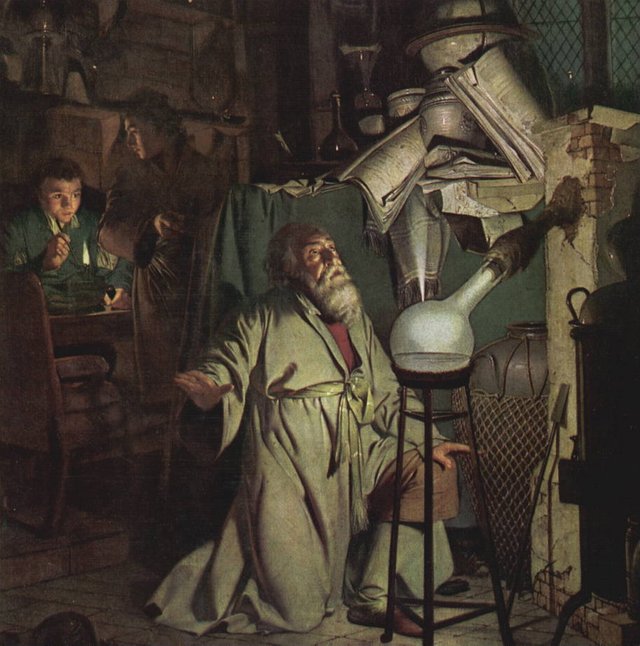Components of ALCHEMY & the PHILOSOPHER'S STONE

Today, alchemy is an idea that has been pigeon-holed into either fantasy fiction or mad scientist craze (often both at the same time), and like any of the ancient sciences of the Mysteries, alchemy as an idea is shelved by most people today before it is even considered. Also like the collection of ancient sciences (astrology, numerology, Tarot, and the Tree of Life, et cetera), most people are confused by the exoteric definition of alchemy, often discarding the philosophy without even regarding the possibility of the art’s allegorical components.
At its most simplistic definition, alchemy is the concept of “transmuting” or purifying base metals into refined metals—often characterized as mercury to gold. The traditional principal chemicals used by the alchemist are sulfur, salt, mercury, and the “secret ingredient” universal transmutation essence, usually called “azoth,” which is considered essentially as the ultimate universal solvent (azoth is also sometimes considered to simply be mercury). The goal of this transmutation is to achieve ultimate purification, most commonly known as the Philosopher’s Stone, and known as the Elixir of Life, and true Enlightenment, which is represented as “gold.”
The literal transmutation of base metals to gold is something that has been acclaimed by an astonishing number of sages and adepts throughout history, but is obviously generally considered as completely impossible today. This article will set aside the detailed arguments for and against this intensely detailed and critical analysis of ancient and modern-day chemistry; and suffice it to say that many of these parallels are yet to adequately surface between the two. This does not make it especially plausible, but it certainly does not make it implausible either. Specifically, this article will focus on the allegorical tenants proposed by alchemy, which have primarily fruited in the philosophies of Hermeticism, and the exponent societies of Hermeticism such as Rosicrucianism and Freemasonry.

Hermes Trismagistus, traditionally known as Thoth, is known as the original alchemist, and his Emerald Tablet contained the secrets to the threefold manifestations of alchemy: the physical (the Philosopher’s Stone of gold), the mental (Enlightenment), and the spiritual (Elixir of Life). Perhaps the most well-known embodiment of Thoth’s teachings are survived in The Kybalion, which was a manuscript published in 1908 by an author(s) known as “the three initiates.” Interestingly, Tarot practitioners consider the knowledge and collection of ancient symbols from the Tarot to have also stemmed ultimately from Thoth’s Emerald Tablet, and Tarot is often coined “the Book of Thoth.”
Etymologically speaking, alchemy is likely the origin of metaphysical philosophy and doctrine, and it can certainly be said that astrology and alchemy are the first two of the ancient sciences, both arising almost inseparably. In turn, numerology, Tarot, the Tree of Life, the I-Ching, and essentially all forms of workable divination can be considered an application of alchemy. Researcher Mark Passio explained this art of alchemy as, “the vehicle for the influence of the soul,” and in this context, transmutation is the software engine with which magickal/metaphysical practice is facilitated.
To further explain this, Manly P. Hall wrote in his work, The Secret Teachings of All Ages:
“Through art [the true process of learning] the whole mass of base metals (the mental body of ignorance) was transmuted into pure gold (wisdom), for it was tinctured with understanding. … Through faith and proximity to God the consciousness of man may be transmuted from base animal desires (represented by the masses of the planetary metals) into a pure, golden, and godly consciousness, illumined and redeemed, and the manifesting God within that one increased from a tiny spark to a great and glorious Being… … Alchemy, therefore, should be regarded as the art of increasing and bringing into perfect flower with the greatest possible expedition.”
To put a cap on this idea, Hall also supplied the old adage, “Within everything is the seed of everything,” which could not explain the essence of alchemy any better. It is within this framework that the application of the art really begins to blossom, and the deeper meanings behind the allegories of the ancient chemistry are manifested. Even the most hardcore alchemists, who were truly attempting to transmute base metals to gold, upheld the idea that the physical could not be manifest until the spiritual and mental were manifest simultaneously—and thus only the sages and adepts were able to perform proper transmutation, and in a sense, the physical transmutation was considered as the final level of manifestation.
In more practical terms, alchemy can very literally be seen as gardening and horticulture, psychotherapy, chemistry, or geology, politics, and any form of art. More precisely, alchemy is the search for gnosis, discovery of gnosis, and application of it—and ultimately how to reproduce this threefold practice in any given aspect of a person’s life at any given time. Here, the Freemasonic allegory of Solomon’s Temple can be found, as each man is the mason of his own mental, physical, and spiritual body, coalescing to create the totality of his existence, which is represented as a Temple. The allegory of Freemasonry implies alchemy, with the idea of the alchemist being a mason who is erecting his own sacred temple with which he pays testament to God.
In terms of the mechanisms of alchemy’s application, and the results of transmutation (the idea of literal metals, again set aside for analytical purposes) The Last American Vagabond has already done a fair amount of elaboration. However, as far as a look into the traditional methods of alchemical application, Samuel Norton, an alchemist of the late 16th century, supplied these fourteen components of alchemical process in his work, The Key of Alchemy:

Solution – the act of passing from a gaseous or solid condition, into one of liquidity.
Filtration – the mechanical separation of a liquid from the undissolved particles suspended in it.
Evaporation – the changing or converting from a liquid or solid state into a vaporous state with the aid of heat.
Distillation – an operation by which a volatile liquid may be separated from substances which it holds in solution.
Separation – the operation of disuniting or decomposing substances.
Rectification – the process of refining or purifying any substance by repeated distillation.
Calcination – the conversion into a powder or calx by the action of heat; expulsion of the volatile substance from a matter.
Commixtion – the blending of different ingredients into new compounds or mass.
Purification – (through putrefaction), disintegration by spontaneous decomposition; decay by artificial means.
Inhibition – the process of holding back or restraining.
Fermentation – the conversion of organic substances into new compounds in the presence of a ferment.
Fixation – the act or process of ceasing to be a fluid and becoming firm; state of being fixed.
Multiplication – the act or process of multiplying or increasing in number, the state of being multiplied.
Projection – the process of turning the base Metals into gold.
Astonishingly, whether someone is trying to make crack-cocaine, grow their own food, or evoke the psychotherapeutic benefits of neuroplasticity, components of alchemy can be found in all. In this light, the grand allegory of the golden Philosopher’s Stone is less of the ability to ascertain a certain type of physical object—and more so, it is the golden knowledge of alchemy itself and how to accurately apply it to the threefold planes of existence at any given point in time. Once again, the ancient secrets that are boasted to be hidden by secret societies for so long are found to be entirely known to the public, and are simply obfuscated. After all, the definition of the term “occult” is simply “hidden” or obfuscated—and once again, the answers are found not in a piece of information previously unknown, but in the reformation of thought and the readjustment of one’s frame of reference. And, indeed, isn’t this one of the fundamental aspects of alchemy to begin with?